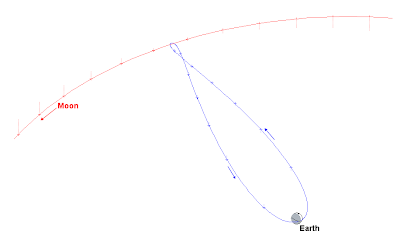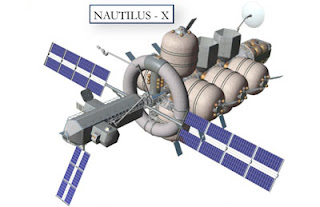The Easy Way To The Moon
I recently described how to fly to the Moon solo using SpaceX hardware. Someone asked me why I worked out an Apollo 8 style flight and didn't just do a simple free return trajectory.. after all, it's a lot easier - and that's actually the reason - it's too dog gone easy. In order to make this interesting I decided to try to think of the easiest way to do a free return trajectory. Preferably, we'd like to use an unmodified spacecraft and launch vehicle and not have to develop any other hardware.
For a start, let's forget this whole idea of an Earth Departure Stage - we'll just throw the Dragon spacecraft to lunar orbit. This sure is simple, but it only gives us 2585 kg to work with. This prompts the question, exactly what is the mass of an unladen Dragon.. yeah, yeah, I know - African or European?
Looking at the Falcon 9 Users Guide we find that it can throw 9358 kg to 51.6º with an altitude of 400 km. SpaceX will happily tell you that the Dragon can carry 3000 kg of pressurized cargo and 3000 kg of unpressurized cargo to the ISS, and has 1290 kg of propellant. So the dry mass has to be around 2068 kg. It's this big number that prompted me to suggest pulling out the heavy docking adapter, etc, but we're not doing that this time.
At some point there is going to be a bunch of used Dragon capsules, and maybe we can get one for cheap. The actual launch is around $56 million, if you can get SpaceX to stop placating NASA's worst fears: another crew lost and everyone asking why the hell they were flying in the first place. If they keep blowing money on a fancy launch abort system, then who knows.. but it'll probably still be smaller than the $150M per seat that Space Adventures is charging for a ride on Russian hardware.
For a single crew member weighing a maximum of 100 kg, you need 11.839 kg of cabin air, 25.83kg oxygen candles, 52.71kg LiHo CO2 scrubbers, and 45kg food and water. Total is 235.379 kg. From our throw mass to lunar transfer orbit we subtract the dry mass and the consumable mass to find 281 kg remaining.
Remember how we took the fuel out of the Dragon? Let's put 245 kg back. This gives us about 300 m/s of delta-v, which is about 10 times as much delta-v as we need to do a free return trajectory. So even if you're flying like Scott Carpenter you should be able to pull it off.
The remaining 36 kg is margin.. or you could take your dog along for the ride.
I have one last thing to say on this insanity. For a while I've been using 3140 m/s as the required delta-v to from Lunar Transfer Orbit directly to the surface of the Moon. Apparently, this estimate is horrible. According to the Lunar Polar Volatiles Explorer concept mission the required delta-v post-TLI breaks down like this:
| Thermal Control Maneuvers | 70 |
| Cruise ACS | 10 |
| Breaking Burn | 2455 |
| Landing ACS | 20 |
| Landing Site Navigation | 25 |
| Descent | 209 |
| Total | 2789 |
For some inexplicable reason they do the breaking burn with a solid rocket motor with 292 seconds of isp. Their maneuvering thrusters have 272 isp, and the terminal descent is done with 296 isp. With this reduced performance they turn 3492 kg at TLI into 1203 kg on the lunar surface.
They get the wet mass there by flying an Atlas V 401 on a 5 day minimum delta-v maneuver, and although that's just fine for cargo, it just means more consumables and radiation exposure for a human. The Falcon 9 has higher mass to LEO, but lower mass to GEO, but it's also 1/3rd the price, so let's stick with the 2585 kg that a Falcon 9 can throw direct to Lunar Transfer Orbit and use a decent storable propellant isp of 312 seconds. With that we can deliver 1038 kg to the surface.
With a inert mass ratio of 0.15 for the lander, the total payload mass is 651 kg. Using the crew/consumable mass above, and assuming 2.5 days to get there, we can spend 28 days on the lunar surface. Or you could try to fit in propellant to fly back.. I guess, if you wanna die in your bed or something.



I started a thread about this very topic on nasaspaceflight.com http://forum.nasaspaceflight.com/index.php?topic=23611.0
ReplyDeleteThe problem is that the dry mass of the dragon is 4200kg according to the spacex brochure. As the name "dry mass" suggests, that does not include propellant. Presumably the 6000kg cargo includes the propellant.
So unfortunately the whole scheme does not work unless you find a way to lighten the dragon significantly.
I'm afraid your "fancy launch abort system" link is broken.
ReplyDeleteYeah dry mass is 4200kg. F9h with EDS would do the job. Or two F9's one with dragon one with eds.
ReplyDeleterklaehn, umm, no. SpaceX is writing that they can deliver 3000 kg of pressurized cargo, 3000 kg of unpressurized cargo and that the Dragon has 1290 kg of propellant. In no sensible universe does anyone count the propellant as part of the cargo. If you want to debate the gross mass you might get a different number.
ReplyDeleteShould that not have been 'Asian or European?'
ReplyDeleteBut why travel cooped up in a Dragon capsule when you can bounce around in a Bigelow module like a chimpanzee?
ReplyDeleteJames, you must work for NASA.. a few things pop to mind, like: price, availability of a launch vehicle, price.
ReplyDeleteThis comment has been removed by the author.
ReplyDeleteBack to rocket talk, how about adding the 2nd stage of the falcon1 as a 3rd stage of the falcon9? Most of it would likely fit in the unpressurized section of Dragon with some adapter mods. Would that provide enough dV?
ReplyDeleteAnonymous, enough for what? :)
ReplyDeleteThe upper stage engine of the Falcon 1 - Kestrel - might be interesting for a cheaper LOX/RP-1 Earth departure stage.
Sorry, but it says in the dragon section of the spacex brochure that the dry mass is 4200kg.
ReplyDeletehttp://www.spacex.com/SpaceX_Brochure_V7_All.pdf
And 6000kg is given as the "total combined upmass capability". At least with the russian progress, the upmass includes propellant, so it would make sense for spacex to use the same metric.
In this brochure http://www.spacex.com/downloads/spacex-brochure.pdf the dry mass is no longer explicitly spelled out.
But a dry mass of 2068kg for a big 7 person capsule with trunk fails a basic plausibility test. Spacex engineers are good, but they still have to work within the laws of physics and materials science.
Which would also suggest that they can throw 10,200 to an ISS orbit.. which also fails a basic plausibility test. Maybe sometime they'll publish an actual number and stand-by it.
ReplyDeleteBut yeah.. I hear ya man.
4,200kg sounds about right based on the F9 guide. It says the F9 can deliver 10,200kg to 300km @ 28.5°. Subtracting 6,000 for cargo leaves the expected mass. ISS inclination loses 616kg.
ReplyDeleteWhat about adding solid rockets to the inside of the trunk to be used to reach escape velocity? They're reliable and you could put a bunch of small ones in for margin in case one or more of the fail.
Andrew, you don't do plane changes with maneuvering thrusters.. the Falcon 9 will launch the Dragon into 51.6°, so that's 9,586kg to 300km. I expect the dry mass value in that ancient flyer is just early speculation which they dropped because they honestly have no idea what the dry mass is going to end up being.
ReplyDeleteWhy use solid motors at all? We're already getting shafted on the ISP by using LOX/LH2 or storable propellant, why would you want to make that worse? :)
Trent, the dragon hot rod buff! I know you want one of your very own. Great post.
ReplyDeleteYou're a nuts and bolts practical guy, but I think there's a place for some consideration of what a spaceship built around a Bigelow habitat (with Merlin engine) might do for us.
Put it in earth orbit for about $300m and you've just created a mobile fuel depot and more to the point a market for fuel to LEO.
Because a Bigelow habitat gives you lots on storage space you can fill it with supplies, send it to EML1 and support a surface mission to the moon.
If you run the numbers, doesn't a refuelable ship going between LEO and EML1 provide some benefit? In other words, can the loss of taking the ship back from EML1 to LEO for resupply be less than throw away vehicles bringing the same amount of supplies to EML1? (eventually going to the lunar surface from there.)
I think it will be dangerous for a man to travel alone into the outer space. But if he is guided and equipped well, that one might be safe. Many dreamed to travel outside the earth.
ReplyDelete